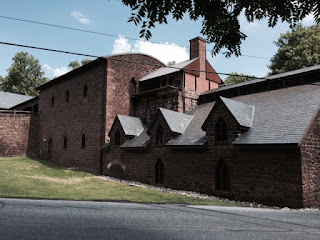 |
| Keystone interns and mentors at Ephrata Cloister (photo by Amy Jukus) |
Scattered throughout the Commonwealth are historical gems, each of which provide a glimpse into the narrative that is our past; among these gems are Ephrata Cloister and the Cornwall Iron Furnace. As an intern with PHMC I have had many great experiences and opportunities; I recently added to that list a field trip to both of these locations.
 |
| (l to r) Sisters' House, Saal, and intern Kendra Ressler |
Our first stop, Ephrata Cloister, was a relatively small community of German immigrants who were seeking a more personal and devout relationship with their religion. Like many others during the 18th century, they sought their liberty of conscience in colonial Pennsylvania. Established in 1732 by Conrad Beissel, who was exiled from Germany because of his religious beliefs, Ephrata Cloister quickly grew into a notable and independent community. They promoted celibacy and remained continuously engaged in the arts and prayer. Their life was simple, yet intentionally uncomfortable and busy. Everyone slept on wooden beds without padding and used blocks of wood as pillows. Their schedule was routine and strenuous.
Each member of the community would wake at approximately six o’clock in the morning and pray for one hour. They would then get right to work in whatever tasks they had for the day, typically whatever skilled labor they had been assigned or volunteered for. At around noon they would pray for another hour and then immediately go back to work. In the evening they would all gather and eat dinner, which was typically a small meal without any kind of meat. They would then go back to work until nine o’clock at night. After three hours sleep, they awoke at midnight to await the coming of Jesus, whom they believed would return within Conrad Beissel’s lifetime; they would wait for two hours and then go back to sleep to wake the next morning and repeat the process. Their only day off was on Saturday, which was the day on which they observed the Sabbath. Such a strict schedule was intended to keep the community more focused on God and less on earthly matters.
 |
| Examples of Fraktur and writing implements |
Each member of the community was educated and learned to read and write. Many delved into the arts, contributing to many of the things for which Ephrata Cloister was known. Their German calligraphy, known as Frakturschriften, can be seen in many of their manuscripts. The iconic white robes donned by each member of the community were all made on site. The community also became extremely well known for its music; they wrote hundreds of hymns that became widely recognized. Perhaps the most significant part of their legacy is their printing. Ephrata Cloister had a large printing operation complete with its own paper mill, printing office and book bindery in which customers could choose what binding they wanted on their books. [Editor's note: ten copies of The Martyr's Mirror, an important religious text printed at Ephrata in the 18th century, are on exhibit in the Visitor Center through September.]
 |
| (center) Physician's House and Small Bake House |
After our guided tour through some of the original remaining buildings and artifacts at Ephrata Cloister, we departed for the Cornwall Iron Furnace. The iron furnace at Cornwall is the only intact furnace of its kind in the Western Hemisphere, and in its heyday was self-sufficient. All of the resources, from the wood for charcoal to the iron ore, were gathered in the hills and surrounding areas of the furnace. Towns were built to provide housing and a sense of community for its workers.
 |
| Elements needed for iron production: iron ore, charcoal, limestone |
The furnace was established by Peter Grubb, who (with his father) immigrated from Cornwall, England, to Pennsylvania. A stone mason, Grubb recognized immediately the significance of the iron ore-rich hills, and by 1742 the furnace (named in honor of his home) had begun operations. After Grubb's death a decade later, Cornwall was passed on to his sons who continued to run the facility until around 1798, when the furnace was acquired by Robert Coleman. Coleman was extremely successful in the management of the furnace and quickly became one of the wealthiest men in the state. By the 1880s a newer and more efficient smelting process, fueled by anthracite coal, made the furnace in Cornwall obsolete. In 1883, after nearly a century and a half of productivity, the Cornwall Iron Furnace ceased operations.
 |
| Cornwall Iron Furmace |
My time with PHMC over the course of the summer has been an enriching and rewarding experience. It opened my eyes to the plethora of locations throughout the state where our past is preserved so that anyone can glimpse first-hand our history, such as at Ephrata and Cornwall. Furthermore, my time here as an intern has bolstered my appreciation of our past; it has broadened my horizons and presented a multitude of new avenues from which to approach the study and preservation of history.



0 comments:
Post a Comment